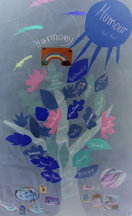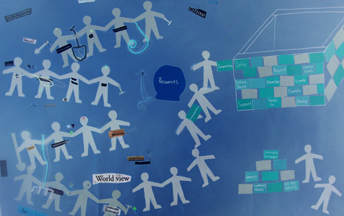The Learning Circles Project |
||
| The Barrie Native Friendship Centre
by Janice Brant |
||
The Barrie Native Friendship Centre (BNFC) was established in 1987. The goal was to provide a meeting place and offer services to Aboriginal people (regardless of legal definition) living in Barrie and the surrounding area. According to Stats Canada Census (1991), 1,555 Native people have settled in and around the Barrie area. There is also a local Métis population of indeterminate number. Today the BNFC has over 200 families registered on their membership list. Since its inception, the Centre has grown to serve specific community needs through programs and services ranging from recreational, educational, social, and cultural activities. Revenue for the centre is generated from various sources such as governments when they are available, foundations, and private grants. Fund raising is an important part of BNFC activities and is done through bingos, raffles, donations, and auctions that are supported by staff, memberships, and community circles hosted by the BNFC. The BNFC has hosted numerous social gatherings and fundraising activities. These activities assist in gathering support for the Centre, as well as raising the consciousness of the whole community by bringing people together. A key factor in the vision of the BNFC is to promote and reaffirm a strong sense of identity and self-worth through cultural awareness and education. They are dedicated to promoting a holistic approach in their programs and services to First Nation, Métis, and non-native visitors. Community participation and the concept of lifelong learning are central to their activities. The BNFC welcomes visitors with brightly painted murals on the exterior walls of their building. The stones in the garden along the walkway are painted with the teachings of the Seven Grandfathers (Trust, Respect, Love, Humility, Bravery, Wisdom, and Honesty) reaffirming traditional cultural beliefs and values. The BNFC hosts several learning circles that foster community building, peer learning, self-awareness, cultural teachings, and holistic healing. One such learning circle is the Hand Drum Circle which consists of approximately eight members. The circle has been consistent for over a year and is growing. The Hand Drum Circle came to be as a result of collaboration between the Aboriginal Health Outreach Worker and the Healing and Wellness Worker. The Aboriginal Health Outreach Worker provides crisis intervention for Aboriginal individuals and families in need of health information and/or referrals to both Native and non-native health care providers. They promote healthy lifestyle awareness and prevention education, as well as advocate for better health services for Aboriginal clients.
The Healing and Wellness Worker provides cultural-based counselling services to Aboriginal individuals and families and/or make referrals to treatment centers and escort clients. They provide cultural teachings and language programming to assist Aboriginal people in their healing, as well as support the participation of their clients in ceremonies.
All members of the Hand Drum Circle have visited the Aboriginal Health Outreach Workers or Healing and Wellness Worker at one time or another looking for a healthier lifestyle. What they would come to learn is that a healthier lifestyle involves a balance of spirit, heart, mind, and body. They sought healing and comfort and wanted to know who they are and where they come from. In response to the needs of the people the Aboriginal Health Outreach Workers organized drum teachings. The Hand Drum Circle began with the story of how the drum came to be. Many Elders, cultural teachers, and traditional healers use the drum for healing and prayer. Making music, drumming, singing, and dancing are integral to Aboriginal culture and promote physical, mental, emotional, and spiritual well being. A drum making workshop was organized by the BNFC and each member had the opportunity to make their own drum. It was followed by a feast ceremony for the drums and the Hand Drum Circle began meeting on Thursday evenings from 6:30 to 8:30. They started by listening to recorded drum songs and invited cultural teachers and Elders to share songs and stories about the drum. Before long they were drumming and singing. The Hand Drum Circle learned to drum and sing by seeing, hearing, feeling, and supporting one another. They listened to stories and observed their teachers drumming and singing. All of their communication is oral and no print materials are used, making the Hand Drum Circle accessible for a broad range of participants, young and old. Anyone interested in drumming and singing is welcome to attend and participate or just observe. The Sewing Circle is another example of a learning circle hosted by the BNFC. The Sewing Circle has 12 members that meet weekly and evolved as a result of the Hand Drum Circle. They needed hand drum bags to protect the drums from the weather or from being damaged. The Hand Drum Circle participants volunteered to make a drum bag for the large social drum belonging to the BNFC and decided they should care for their drums in the same respectful manner. Circle participants began donating fabric and seeking out other donations. The Sewing Circle started with a few donations and some willing teachers. Later they were able to acquire some funding to purchase materials and fabric to make traditional clothing. Like the Hand Drum Circle, the Sewing Circle opens with an offering of thanksgiving, circle, and smudge in honour of the people gathered and to create a safe space for learning and sharing. The Sewing Circle is not simply about learning to sew, it is about learning their culture and traditional practices, beliefs, and values. Together they explored and learned about their clans, inviting Elders and cultural teachers to share the clan teachings with them. They invited traditional dancers to model their clothing and talk about how it was made. Elders shared teachings about the colours and what they represent. They learned about the different styles and types of traditional clothing, as well as who wore them and what purposes they served. Since their initial aim to make hand drum bags, the Sewing Circle has evolved into making various pieces of traditional and ceremonial dress, as well as blankets to raise funds for the BNFC. They share food and friendship at the Sewing Circle and have developed a social support network. The method of teaching and learning is predominately oral, although some literacy and numeracy skills are needed for reading patterns and instruction. The Sewing Circle participants work collaboratively on their projects, helping one another and therefore participants with lower literacy are supported by other participants. This ensures that the circle is inclusive of all people wishing to participate in the Sewing Circle. The Hand Drum Circle and Sewing Circle hosted by the BNFC operate and collect materials primarily through donations and fundraising, although their host has at times been able to access small allocations of funding to support their activities. The funds are often used to support Elders and traditional teachers as they travel to visit the centre and the circles. These funds have in the past usually stemmed from federal initiatives such as the Healing and Wellness Strategy. Greater access to funding for these circles could not only support the continued learning of individual participants, but essentially contribute to building healthier and stronger Aboriginal families and communities. |
||

